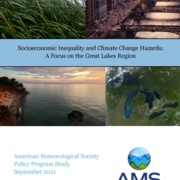Executive Summary
Society is reaching an inflection point on two critical issues: 1) a growing risk of climate
change hazards, including disaster events due to changes in weather trends and
ecological disruption, and 2) socioeconomic injustices and inequality, as illustrated by
the impacts of the ongoing COVID-19 pandemic and recent racial unrest. Due to
increasing societal awareness and momentum to address both climate change and
socioeconomic issues, the combination of these forces presents an opportunity for
substantial change aimed at creating a safer and more equitable society. Failing to
simultaneously consider climate hazards and socioeconomic inequity risks worsening
one issue in an attempt to redress the other.
The impacts of climate change are growing, widespread, and detrimental, and they
exacerbate existing inequalities. Individuals and communities that are already
experiencing socioeconomic vulnerability, perhaps inherited from past unjust practices,
are less likely to have the resources to proactively build resilience against future climate
risks and to recover from them. Therefore, when climate hazards do occur, these
individuals and communities are exposed at a greater frequency and intensity than
those of high socioeconomic status (SES). This results in further diminished resources
and increased susceptibility to future risks for those affected. Yet, these hazards are
becoming more intense and occurring more often due to climate change, increasing the
chances that these low SES communities are exposed to climate risks.
Climate change and socioeconomic inequality are two “wicked problems.” Wicked
problems lack clarity in approach and solution; every action and choice implemented
against these problems will have lasting consequences that cannot be undone. Working
within the wicked problems framework, there are three steps that can address the
systems-level approach that such immense and complex issues require: 1)
implementation of numerous pilot projects to assess various action options, 2) rapid
detection of success and failure, and 3) rapid dissemination of the information
discovered and lessons learned.
Given the interconnectedness of climate risk with societal well-being, this report
embarks on a review of this relationship, bounded by a particular geographic region: the
American Great Lakes Region (GLR). The GLR is experiencing and will continue to
experience the interaction of socioeconomic inequality and climate change due to the
region’s reliance on natural resources for its industries, employment, and income. The
American Meteorological Society (AMS) Policy Program conducted an in-depth Intern
Report on this topic that analyzes the region’s socioeconomics and climate change risks
and hazards separately and how these elements integrate in the region. Using this
Intern Report as background knowledge, the AMS Policy Program sought to promote
collaboration, open lines of communication, and discuss policy options across various
sectors in order to address the interaction of socioeconomic inequality and climate
change in the GLR. This conversation took place during a two-part workshop that
gathered participants from academic, public, nongovernmental organization (NGO),
and other sectors with ties to the GLR.
This study focuses on four aspects of addressing and exploring solutions for climate
change, socioeconomic inequality, and their interactions that reflect the core values,
lessons, and ideas that emerged from the workshop discussions: 1) community
engagement, 2) partnerships and networks, 3) funding and grant systems, and 4) policy.
1. Community engagement, the process of approaching the community in a manner
that is conducive to member participation, centers around the idea that community
members are most familiar with their own wants and needs in response to climate
and socioeconomic inequities. This idea acknowledges that the first step to
successful engagement is to ensure accessible participation. Additionally, the
incorporation of place-based knowledge and tailored solutions are helpful because
they address challenges in a manner that is community led. Transitions of power,
resources, or places at the table to marginalized groups may encourage greater
participation of better suited yet underrepresented groups in the decision-making
process.
2. Partnerships and networks, the vehicles for inter- and intracommunity
collaboration, are empowered by sustained relationships rather than short-term,
one-off projects. Communities and experts may be better supported by
incorporating accessible information, value systems, and cooperation between
technology, engineering, natural sciences, and social sciences into the decisionmaking
framework, instead of prioritizing the accrual of additional knowledge. This
approach may support existing networks and individuals who are already working to
address a designated problem, leading to more mutually beneficial outcomes.
3. Funding and grant systems are designed to provide resources to a community, yet
place constraints on already limited resources by requiring time, expertise, and
money to apply to funds and grants. This creates a bottleneck and prevents some
communities form receiving the resources they need.
4. Policy better captures the nuance of challenges and opportunities when tailored to a
community in a bottom-up approach. This contrasts the implementation of topdown
polices that rely on current systems in place—systems that are founded on and
perpetuated by outdated ideologies. Therefore, building frameworks for solutions for
climate change and socioeconomic inequality within these systems can be
challenging.
While these frameworks outline opportunities for more intentional and detailed
engagement, there are complexities and particularities at every scale that require
awareness and analytical consideration. Local, small-scale approaches are not
automatically superior approaches; they still empower a certain subset of people to
overshadow less-powerful groups. Additionally, it cannot be assumed that the
community shares a unified agenda, or that this agenda is congruent with social justice.
To make these assertions risks a fall into the Local Trap—assuming an inherent positive
quality of small-scale efforts that may or may not be present. Effective methods for
societal progress exist at all scales.
